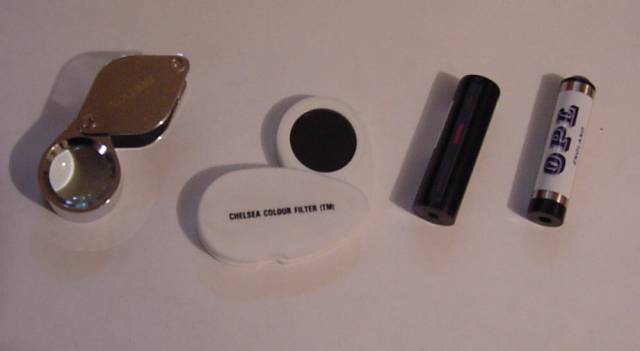Gem
Identification
Identifying gem stones is a science in itself.
Since chemical analysis or even hardness testing would damage or
destroy a stone most methods use optical properties.
One of the most useful tools is the refractometer.
Most gems are doubly refractive meaning that there will be two readings
depending in polarization of light note the Polaroid filter that can be
rotated on the eyepiece. The gem is placed on the hemicylinder with a
drop of refractometer liquid between. The angle that light reflects off
the stone is seen on a scale. The drawback is that it will only read up
to the refractive index of the liquid 1.81.

Other tools shown here are also useful.
The most used and least expensive is the 10x loupe on the left. It
gives magnification that can be used to identify inclusions or other
imperfections in a stone. Next is the chelsea filter. Its main use is
to detect chrome in emeralds tourmaline and some garnets. It will also
separate synthetic spinel often mixed with natural aquamarine at some
cutting plants. The other two shown here are the dichroscope and
spectroscope. Given these tests a gemologist can usually identify a
stone with reasonable certainty. The hardest are synthetics that have
the same optical properties as natural. That is where a microscope
comes in handy to identify microscopic inclusions.
There is more to learn than I can put here
but if you want to learn more I highly recommend "Gem Identification
made easy" by Antoinette Matlins. It is well written easy to understand
and covers most of what you would learn from a GIA course costing
hundreds of dollars.
http://www.gemstonepress.com/
Email Me Here
My Index Page


